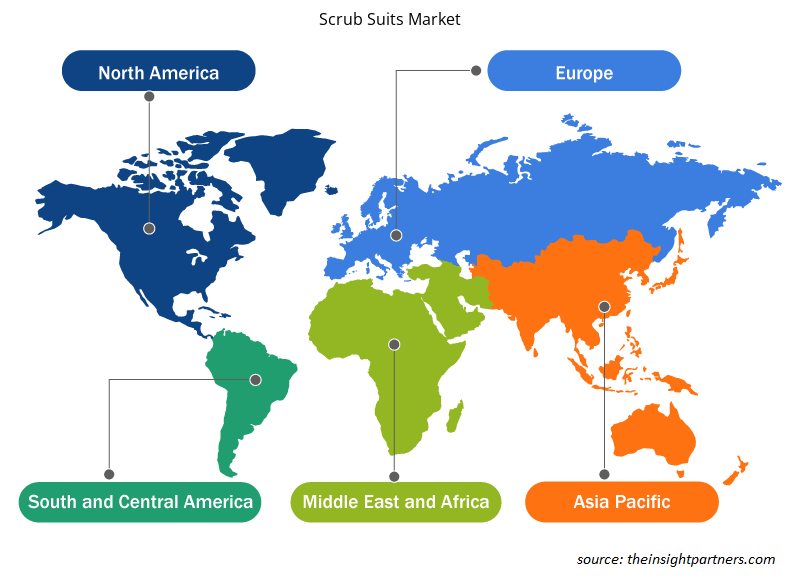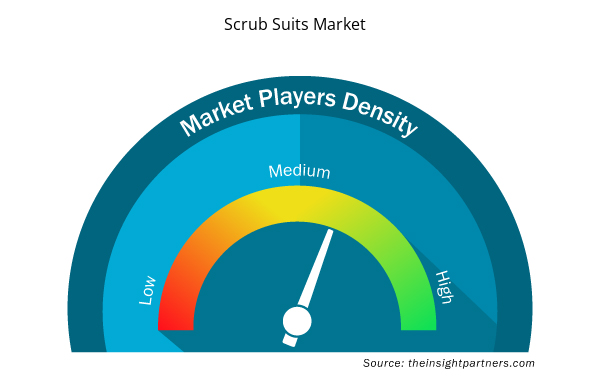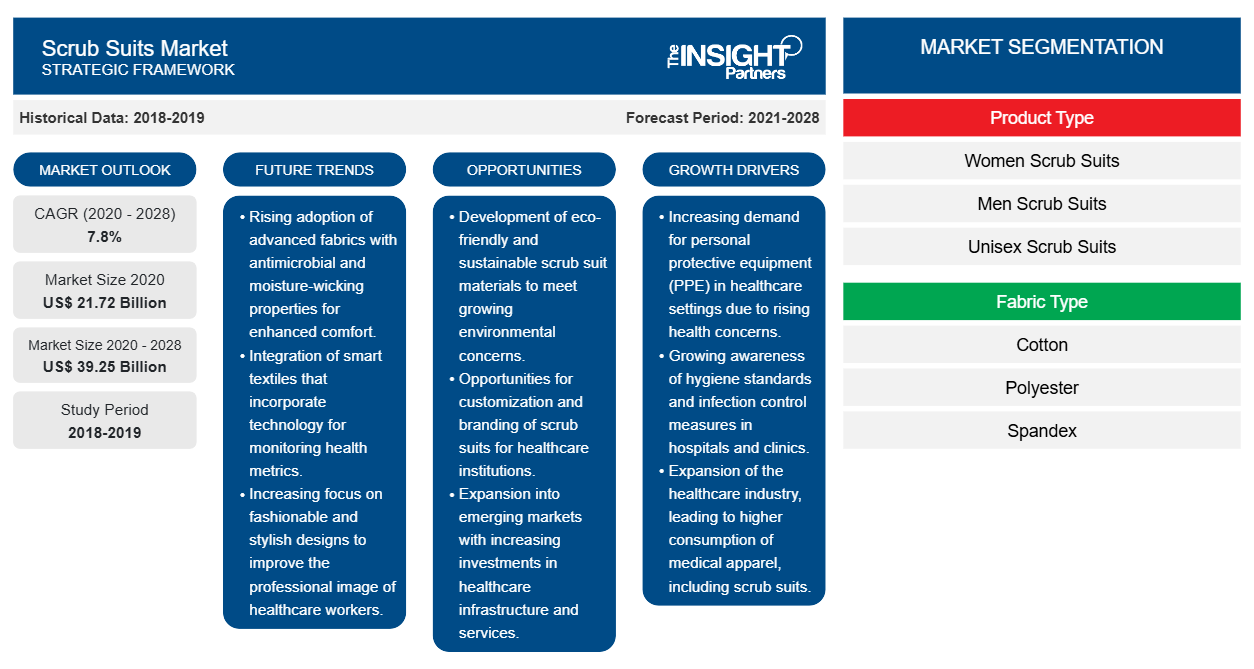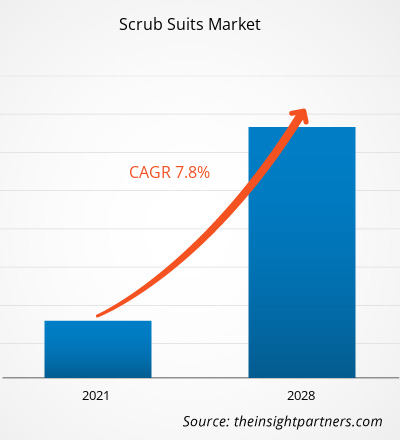Le marché des combinaisons de gommage a été évalué à 21 722,45 millions USD en 2020 et devrait atteindre 39 253,71 millions USD d'ici 2028 ; il devrait croître à un TCAC de 7,8 % de 2021 à 2028.CAGR of 7.8% from 2021 to 2028.
Les combinaisons de travail sont très utilisées dans les secteurs médical et de la santé. Les combinaisons sont essentiellement des vêtements sanitaires utilisés par les chirurgiens, les médecins, les infirmières et les autres travailleurs impliqués dans les soins aux patients dans les hôpitaux, les cliniques et autres. Aujourd'hui, ces combinaisons sont portées par de nombreux personnels hospitaliers. Leur utilisation s'est également étendue à l'extérieur des hôpitaux, dans des endroits où il pourrait sembler que les vêtements soient porteurs d'agents infectieux. Le marché des combinaisons de travail offre un énorme potentiel et une base de clientèle aux acteurs du marché des combinaisons de travail, car les médecins, le personnel médical et même les patients sont préoccupés par les maladies infectieuses qui peuvent se propager dans les hôpitaux.
En 2020, l'Asie-Pacifique détenait la plus grande part du marché mondial des combinaisons de travail et devrait également enregistrer le TCAC le plus élevé du marché au cours de la période de prévision. La croissance du marché dans la région est principalement attribuée à la présence de grands fabricants en Asie-Pacifique. En outre, l'augmentation des activités de production de combinaisons de travail devrait alimenter la croissance du marché dans la région au cours de la période 2021-2028. De plus, des réglementations strictes encadrées par le gouvernement encouragent également l'utilisation de vêtements médicaux pour prévenir les infections. L'utilisation de combinaisons de travail dans les pays d'Asie-Pacifique augmente encore en raison de l'amélioration des infrastructures de santé et de la pandémie de COVID-19 en cours. En outre, les faibles coûts de fabrication et d'investissement dans des pays comme l'Inde et la Chine attirent de nouveaux investissements et de meilleures opportunités pour les entreprises du textile et de l'habillement.
La pandémie de COVID-19 en cours a modifié le statut de l'industrie des combinaisons de travail. L'épidémie a faussé l'efficacité opérationnelle et perturbé les chaînes de valeur en raison de la fermeture soudaine des frontières nationales et internationales. Cependant, dans le contexte de la pandémie, la demande de combinaisons de travail a augmenté à l'échelle mondiale en raison de la prise de conscience croissante de la santé et de la sensibilisation croissante à la protection contre les infections microbiennes. Cependant, l'accent mis sur la production juste à temps freine la croissance du marché des combinaisons de travail. D'autre part, l'importance croissante de la protection des travailleurs et des patients contre les infections contractées à l'hôpital et la prévalence croissante de la COVID-19 devraient stimuler la demande de combinaisons de travail au cours de la période de prévision.
En outre, plusieurs entreprises se sont manifestées pour répondre à la demande croissante de combinaisons de travail pendant la pandémie de COVID-19. En outre, les mesures efficaces prises par diverses associations, telles que l'Industrial Fabrics Association International, soutenues par des initiatives gouvernementales positives pour protéger les travailleurs de la santé de première ligne, devraient générer une demande de combinaisons de travail dans les années à venir. En outre, les investissements importants d'entreprises de premier plan dans le développement de produits de pointe constituent un autre facteur de soutien à la croissance du marché.
Personnalisez ce rapport en fonction de vos besoins
Vous bénéficierez d'une personnalisation gratuite de n'importe quel rapport, y compris de certaines parties de ce rapport, d'une analyse au niveau des pays, d'un pack de données Excel, ainsi que de superbes offres et réductions pour les start-ups et les universités.
- Obtenez les principales tendances clés du marché de ce rapport.Cet échantillon GRATUIT comprendra une analyse de données, allant des tendances du marché aux estimations et prévisions.
Aperçu régional du marché des combinaisons médicales
Les tendances régionales et les facteurs influençant le marché des combinaisons de soins infirmiers tout au long de la période de prévision ont été expliqués en détail par les analystes d’Insight Partners. Cette section traite également des segments et de la géographie du marché des combinaisons de soins infirmiers en Amérique du Nord, en Europe, en Asie-Pacifique, au Moyen-Orient et en Afrique, ainsi qu’en Amérique du Sud et en Amérique centrale.

- Obtenez les données régionales spécifiques au marché des combinaisons de travail
Portée du rapport sur le marché des combinaisons médicales
| Attribut de rapport | Détails |
|---|---|
| Taille du marché en 2020 | 21,72 milliards de dollars américains |
| Taille du marché d'ici 2028 | 39,25 milliards de dollars américains |
| Taux de croissance annuel composé mondial (2020-2028) | 7,8% |
| Données historiques | 2018-2019 |
| Période de prévision | 2021-2028 |
| Segments couverts | Par type de produit
|
| Régions et pays couverts | Amérique du Nord
|
| Leaders du marché et profils d'entreprises clés |
|
Densité des acteurs du marché des combinaisons médicales : comprendre son impact sur la dynamique commerciale
Le marché des combinaisons de travail connaît une croissance rapide, tirée par la demande croissante des utilisateurs finaux en raison de facteurs tels que l'évolution des préférences des consommateurs, les avancées technologiques et une plus grande sensibilisation aux avantages du produit. À mesure que la demande augmente, les entreprises élargissent leurs offres, innovent pour répondre aux besoins des consommateurs et capitalisent sur les tendances émergentes, ce qui alimente davantage la croissance du marché.
La densité des acteurs du marché fait référence à la répartition des entreprises ou des sociétés opérant sur un marché ou un secteur particulier. Elle indique le nombre de concurrents (acteurs du marché) présents sur un marché donné par rapport à sa taille ou à sa valeur marchande totale.
Les principales entreprises opérant sur le marché des combinaisons médicales sont :
- Marques Careismatic
- UNIFORMES BARCO
- Uniformes médicaux Adar, LLC
- UNIFORMES MAEVN
- Gommages Smitten
Avis de non-responsabilité : les sociétés répertoriées ci-dessus ne sont pas classées dans un ordre particulier.

- Obtenez un aperçu des principaux acteurs du marché des combinaisons médicales
Marché des combinaisons médicales, par type de produit
- Combinaisons de travail pour femmes
- Tenues médicales pour hommes
- Combinaisons de travail unisexes
Marché des combinaisons médicales, par type de tissu
- Coton
- Polyester
- Spandex
- Rayonne
- Mélanges
- Autres
Marché des tenues médicales, par canal de distribution
- Marchandiseurs de masse
- Magasins spécialisés
- En ligne
- Autres
Profils d'entreprise
- Marques Careismatic
- UNIFORMES BARCO
- Uniformes médicaux Adar, LLC
- UNIFORMES MAEVN
- Gommages Smitten
- Jaanuu, Inc
- Med Couture
- Clin d'oeil merveilleux
- FIGS, INC
- Fils de vie
- Analyse historique (2 ans), année de base, prévision (7 ans) avec TCAC
- Analyse PEST et SWO
- Taille du marché Valeur / Volume - Mondial, Régional, Pays
- Industrie et paysage concurrentiel
- Ensemble de données Excel


- Vision Care Market
- Blood Collection Devices Market
- Print Management Software Market
- Electronic Shelf Label Market
- Frozen Potato Market
- Space Situational Awareness (SSA) Market
- Quantitative Structure-Activity Relationship (QSAR) Market
- Underwater Connector Market
- Green Hydrogen Market
- Ceramic Injection Molding Market

Report Coverage
Revenue forecast, Company Analysis, Industry landscape, Growth factors, and Trends

Segment Covered
This text is related
to segments covered.

Regional Scope
North America, Europe, Asia Pacific, Middle East & Africa, South & Central America

Country Scope
This text is related
to country scope.
Questions fréquemment posées
In 2020, the women scrub suits segment accounted for a larger share of the global scrub suits market. Women scrub suits a loose-fitting, usually two-piece garment, often of green cotton, worn by surgeons and assisting personnel in an operating room. Scrubs are required protective clothing that helps keep cross-contamination to a minimum level. Women love fashion, whether it is on the job, casually running errands, or going out on the town, in choosing the right scrub suits. There are number of types and colors of women scrub suits that can be picked. Also, this scrub suit can be cleaned with ease and are generally cleaner than regular clothes. Thus, the demand for women scrub suits is expected to register highest share in the global scrub suits market.
The major players operating in the global scrub suits market are Careismatic Brands; Adar Medical Uniforms, LLC.; Med Couture; Barco Uniforms; Smitten Scrubs; Maevn Uniforms; Jaanuu, Inc.; Cowboy Jungle, Inc. (Wonderwink); Lifethreads; and Figs, Inc.; among others.
North America is expected to be the fastest-growing market for scrub suits in the coming years. The rise in demand for scrub suits mainly from medical industry is fueling the growth of this market in the region. Also, increasing concerns towards health and growing awareness mainly related to protection from germs as well as microorganisms are further creating more demand for scrub suits among medical staff in this region and it is the key factors driving this market. Scrub suits play a crucial role as there are so many microorganisms present on the body parts, even after continuing with the sterilization process and strict hygiene. It is further used to avoid the transmission of infection in case of performing surgeries. The growth of the medical and healthcare industry is further influencing the scrub suits market in the region.
Trends and growth analysis reports related to Consumer Goods : READ MORE..
The List of Companies - Scrub Suits Market
- Careismatic Brands
- BARCO UNIFORMS
- Adar Medical Uniforms, LLC
- MAEVN UNIFORMS
- Smitten Scrubs
- Jaanuu, Inc
- Med Couture
- WonderWink
- FIGS, INC
- LifeThreads
The Insight Partners performs research in 4 major stages: Data Collection & Secondary Research, Primary Research, Data Analysis and Data Triangulation & Final Review.
- Data Collection and Secondary Research:
As a market research and consulting firm operating from a decade, we have published and advised several client across the globe. First step for any study will start with an assessment of currently available data and insights from existing reports. Further, historical and current market information is collected from Investor Presentations, Annual Reports, SEC Filings, etc., and other information related to company’s performance and market positioning are gathered from Paid Databases (Factiva, Hoovers, and Reuters) and various other publications available in public domain.
Several associations trade associates, technical forums, institutes, societies and organization are accessed to gain technical as well as market related insights through their publications such as research papers, blogs and press releases related to the studies are referred to get cues about the market. Further, white papers, journals, magazines, and other news articles published in last 3 years are scrutinized and analyzed to understand the current market trends.
- Primary Research:
The primarily interview analysis comprise of data obtained from industry participants interview and answers to survey questions gathered by in-house primary team.
For primary research, interviews are conducted with industry experts/CEOs/Marketing Managers/VPs/Subject Matter Experts from both demand and supply side to get a 360-degree view of the market. The primary team conducts several interviews based on the complexity of the markets to understand the various market trends and dynamics which makes research more credible and precise.
A typical research interview fulfils the following functions:
- Provides first-hand information on the market size, market trends, growth trends, competitive landscape, and outlook
- Validates and strengthens in-house secondary research findings
- Develops the analysis team’s expertise and market understanding
Primary research involves email interactions and telephone interviews for each market, category, segment, and sub-segment across geographies. The participants who typically take part in such a process include, but are not limited to:
- Industry participants: VPs, business development managers, market intelligence managers and national sales managers
- Outside experts: Valuation experts, research analysts and key opinion leaders specializing in the electronics and semiconductor industry.
Below is the breakup of our primary respondents by company, designation, and region:

Once we receive the confirmation from primary research sources or primary respondents, we finalize the base year market estimation and forecast the data as per the macroeconomic and microeconomic factors assessed during data collection.
- Data Analysis:
Once data is validated through both secondary as well as primary respondents, we finalize the market estimations by hypothesis formulation and factor analysis at regional and country level.
- Macro-Economic Factor Analysis:
We analyse macroeconomic indicators such the gross domestic product (GDP), increase in the demand for goods and services across industries, technological advancement, regional economic growth, governmental policies, the influence of COVID-19, PEST analysis, and other aspects. This analysis aids in setting benchmarks for various nations/regions and approximating market splits. Additionally, the general trend of the aforementioned components aid in determining the market's development possibilities.
- Country Level Data:
Various factors that are especially aligned to the country are taken into account to determine the market size for a certain area and country, including the presence of vendors, such as headquarters and offices, the country's GDP, demand patterns, and industry growth. To comprehend the market dynamics for the nation, a number of growth variables, inhibitors, application areas, and current market trends are researched. The aforementioned elements aid in determining the country's overall market's growth potential.
- Company Profile:
The “Table of Contents” is formulated by listing and analyzing more than 25 - 30 companies operating in the market ecosystem across geographies. However, we profile only 10 companies as a standard practice in our syndicate reports. These 10 companies comprise leading, emerging, and regional players. Nonetheless, our analysis is not restricted to the 10 listed companies, we also analyze other companies present in the market to develop a holistic view and understand the prevailing trends. The “Company Profiles” section in the report covers key facts, business description, products & services, financial information, SWOT analysis, and key developments. The financial information presented is extracted from the annual reports and official documents of the publicly listed companies. Upon collecting the information for the sections of respective companies, we verify them via various primary sources and then compile the data in respective company profiles. The company level information helps us in deriving the base number as well as in forecasting the market size.
- Developing Base Number:
Aggregation of sales statistics (2020-2022) and macro-economic factor, and other secondary and primary research insights are utilized to arrive at base number and related market shares for 2022. The data gaps are identified in this step and relevant market data is analyzed, collected from paid primary interviews or databases. On finalizing the base year market size, forecasts are developed on the basis of macro-economic, industry and market growth factors and company level analysis.
- Data Triangulation and Final Review:
The market findings and base year market size calculations are validated from supply as well as demand side. Demand side validations are based on macro-economic factor analysis and benchmarks for respective regions and countries. In case of supply side validations, revenues of major companies are estimated (in case not available) based on industry benchmark, approximate number of employees, product portfolio, and primary interviews revenues are gathered. Further revenue from target product/service segment is assessed to avoid overshooting of market statistics. In case of heavy deviations between supply and demand side values, all thes steps are repeated to achieve synchronization.
We follow an iterative model, wherein we share our research findings with Subject Matter Experts (SME’s) and Key Opinion Leaders (KOLs) until consensus view of the market is not formulated – this model negates any drastic deviation in the opinions of experts. Only validated and universally acceptable research findings are quoted in our reports.
We have important check points that we use to validate our research findings – which we call – data triangulation, where we validate the information, we generate from secondary sources with primary interviews and then we re-validate with our internal data bases and Subject matter experts. This comprehensive model enables us to deliver high quality, reliable data in shortest possible time.


 Obtenez un échantillon gratuit pour ce rapport
Obtenez un échantillon gratuit pour ce rapport